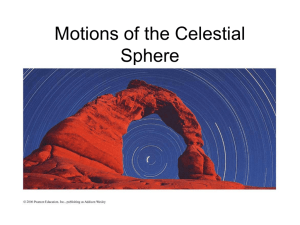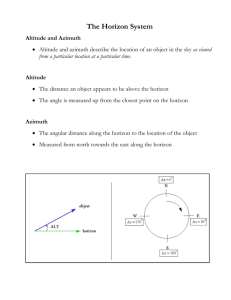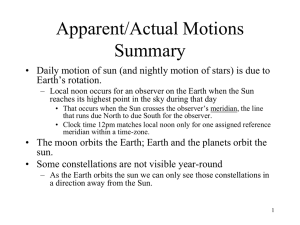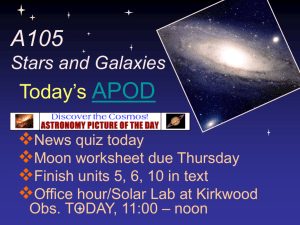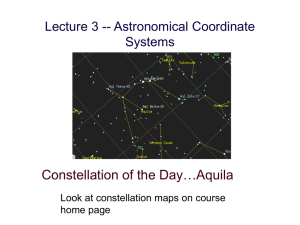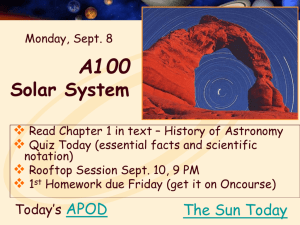Patterns in the Sky (cont)
advertisement
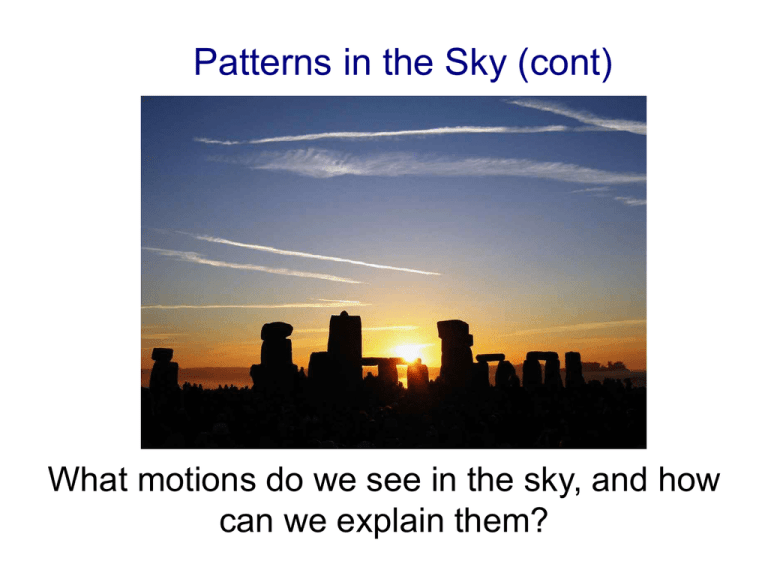
Patterns in the Sky (cont) What motions do we see in the sky, and how can we explain them? What do we mean by “Patterns in the Sky” • Grouping of celestial objects (Sun, Moon, planets, groups of stars) that we see in the sky • How do we describe those in terms of numbers (“the Greek obsession with geometry”) • What are the cyclical recurrences of these phenomena? • How do we explain these in terms of a modern understanding of the solar system? • See Chapter 2 of book (later 3 and 4) • Let’s begin with the numbers we use to describe the locations of objects in the sky (“angles on angles”). Angular measure (degrees) Angular measure (degrees) Smaller units of angular measure….arcseconds Coordinate systems in astronomy…the Horizon System Important terms in describing the position of objects in the sky • • • • • • Celestial sphere Zenith (a location on the sky) Horizon Meridian Altitude angle Azimuth angle The Circumpolar Stars…”The Immortals” to the ancient Egyptians We see the Sun, Moon, planets, and stars rise in the east, transit the meridian, and set in the west demonstration Question: To our eyes, it looks like the celestial sphere is turning on an axis over our heads. What is really going on? Fundamental astronomical observation: The path of the Sun across the sky changes from one day to the next. See Figure 2.16 of text The changes in the rising (and setting) locations of the Sun are big How do we understand these changes during the year? • Method 1: introduce a second coordinate system for use on the sky • Method 2: understand the physics of the solar system (later) • New coordinate system is like defining your location on Earth (what are the coordinates for locating a position on Earth?) Coordinates to determine a location on Earth Outside looking at the surface of a sphere New system: the equatorial coordinate system. Coordinates fixed with respect to the stars From inside looking out at the surface of a sphere The north celestial pole and the celestial equator What is here on the sky? The equatorial coordinate system: right ascension and declination Motion of the celestial sphere at the north pole The changing appearance of the sky at different latitudes Demo Measuring the position of the Sun against the background stars The path of the Sun through the stars Another and related astronomical fact: During the course of the year, the Sun moves against the background stars, just like the planets Another great circle on the sky…the ecliptic Important terms and concepts in the equatorial coordinate system • Celestial equator • North and south celestial pole • Right ascension (coordinate like longitude, only units are hours, minutes) • Declination (coordinate like latitude) • Ecliptic • Vernal equinox (sometimes called “the first point of Aries”)
